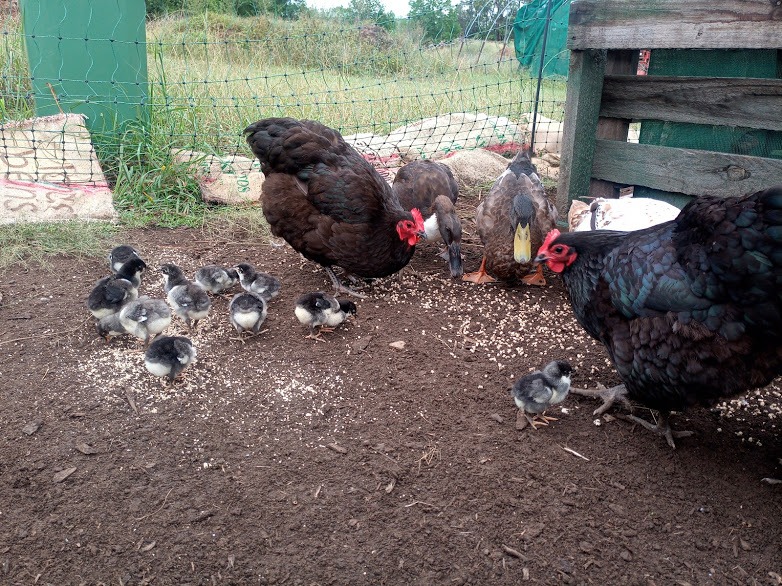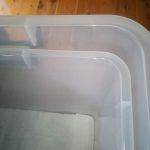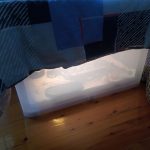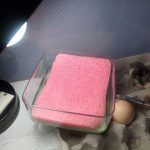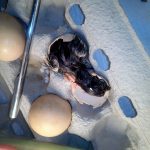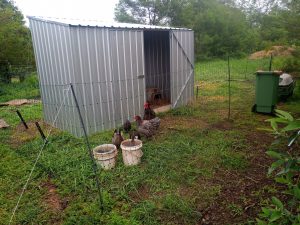Several weeks ago one of my Australorp girls went broody and I wanted to hatch as many chicks as I possibly could. She had only accumulated 5 eggs – and I wanted more. I decided that I would let the other hens continue to add to her clutch every day, knowing that this would create a staggered hatching.
After about a week a SECOND hen went broody and so I realized that they could handle even more eggs. So the number of eggs gradually increased over a two week period, after which I did not allow any new eggs to be added to the nest. My total egg count ended up at 18.
The problem with a staggered hatching like this is that after the first chick hatches the hen will only continue to sit on the remaining eggs for about 2 days to wait for more to hatch. After this time she must abandon the nest so that she can care for her already hatched chicks. In anticipation for this I ordered an egg incubator which was due to arrive in plenty of time for me to continue hatching the last chicks myself. All was going to plan!
My beautiful hens were dutiful mothers. Getting off the nest once a day to run like the wind for a very fast feed, poo, drink and dust bath and then run back to the nest. The days past and my incubator never arrived. I was getting worried as the hatching due date was getting close and still no incubator, despite several desperate emails to the supplier.
Anyone who has hatched chickens will be aware of what is known as “lockdown”. This is the time during hatching (day 18 for chickens – the last 3 days) when the incubator is closed up and the humidity is increased. The reason for this is because when the chick cracks through the shell (called an “external pip”) the surrounding air enters the egg and starts to dry out the inner membrane. The air needs to be kept humid so the membrane stays flexible and doesn’t toughen up and stick to the hatching chick, making it impossible for the chick to hatch. How was I going to obtain the necessary high humidity without an incubator?
I have hatched my own chicks in the past using a plastic tub and a desk lamp, but during lockdown I had moved the eggs into an incubator. In the tub it had been very difficult to keep a constant temperature of 37.5°C. A Styrofoam box is recommended but I was not able to get one so I had wrapped my plastic tub in thick towels instead. I was constantly having to monitor and adjust things to keep the temperature right, but it had been IMPOSSIBLE to get the humidity up to the recommended level. I was nervous about trying this again – this time without the incubator to use during the final days.
The answer to controlling the temperature came to me completely by chance. We had recently purchased two storage tubs, one slightly smaller than the other, and they sat nested together in the hallway. I found that the insulating air gap between these two tubs was perfect for maintaining the temperature inside. So a desk lamp with a 42W globe went inside the tubs and I threw a small doona over the top of the box. My inner tub was about 86L capacity and the outer tub only slightly larger so the air gap between the two was not too big. It worked perfectly!
Under my broody hens the first chicks hatched bang on target and, like clockwork, the two hens sat for an extra 2 days before leaving the unhatched eggs behind and taking 8 chicks out into the big wide world. In the afternoon I found the abandoned eggs – stone cold and with one chick so close to hatching that I could hear him chirping loudly inside the egg as I walked up. I rushed the 10 cold eggs into my home made incubator.
After the eggs had warmed up I candled them all to look for signs of life. Three of the eggs were no good. One had obviously been infertile from the start and 2 others were “quitters” (the chick had died). I removed these eggs and left the other 7 to hatch.
I placed a wet sponge in a container and placed this directly under the lamp. While this probably helped to raise the humidity slightly I know if was nothing even close to how humid it should be (I recalled how it felt in the incubator during lockdown). I waited nervously for my chicks to start hatching.
To my surprise all 7 chicks hatched without any issue of becoming stuck in the shell due to low humidity. Every night I would take any newly hatched chicks and put them under the broody hens. They are now all being raised by my hens in one big happy family.
After this experience I am wondering just how important the “lockdown” period actually is. We had no rain whatsoever during this hatching period so the ambient humidity was not very high and my wet sponge in the hatching tub was all I had to rely on. I’m not saying that lower humidity is BETTER necessarily, but I am saying that maybe it is something that we shouldn’t be so scared of getting wrong….
Now run outside and create your oasis!
Jo

